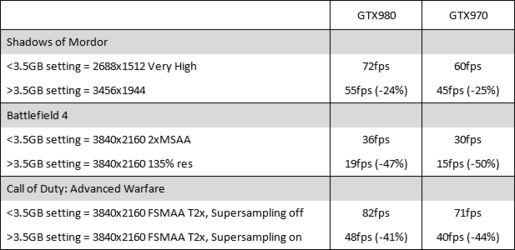This in turn is why the 224GB/sec memory bandwidth number for the GTX 970 is technically correct and yet still not entirely useful as we move past the memory controllers, as it is not possible to actually get that much bandwidth at once when doing a pure read or a pure write. In the case of pure reads for example, GTX 970 can read the 3.5GB segment at 196GB/sec (7GHz * 7 ports * 32-bits), or it can read the 512MB segment at 28GB/sec, but it cannot read from both at once; it is a true XOR situation. The same is also true for writes, as only one segment can be written to at a time...
...Despite all of this, achieving peak memory bandwidth performance on the GTX 970 is still possible, but it requires much more effort since simple striping will not do the trick. The easiest and most effective solution in this regard is to interleave reads and writes over the segments, such that one segment is writing while another segment is reading. Interleaving in this fashion allows both segments to work at once – avoiding the blocking effect of the shared read and write buses – and makes it more likely that both segments are doing useful work rather than waiting for their turn on an operation. However because this is only applicable to situations where more than 3.5GB of VRAM is in use and both segments are necessary, this means it's only theoretically possible to achieve 224GB/sec when more than 3.5GB of VRAM is in use. In any situations below 3.5GB we are de-facto limited to just the larger segment, in which case there are only 7 memory channels (196GB/sec) to stripe memory operations across. NVIDIA could of course interleave operations sooner than that and use both segments more often, but due to the blocking effect we've discussed before the performance hit from using the 512MB segment can quickly become greater than any gains.

